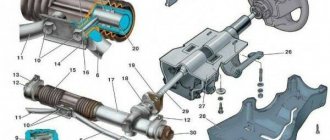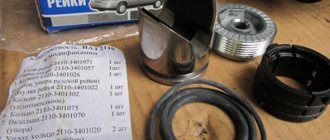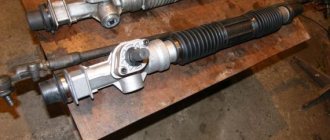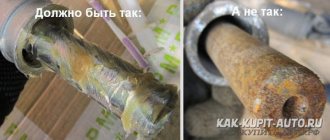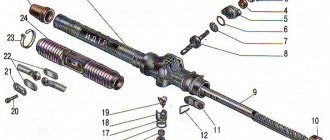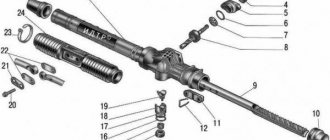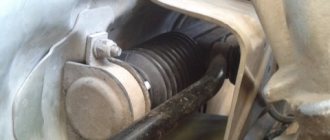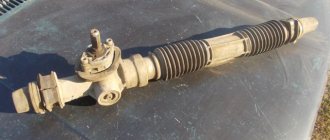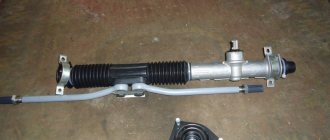What to do when the steering rack leaks, why it happens and how to fix it. Most modern vehicles use power steering to make it easier to control the car while driving. Designers have developed several types of such devices. They can be:
- Hydraulic.
- Electromechanical.
- Mixed.
After some period of operation of the power steering, the owner may notice that the steering rack has leaked. If such a malfunction appears on your car, you need to fix the problem immediately. If you have the ability to handle metalwork tools and know the structure of this unit, you can fix the malfunction yourself. Before you begin to fix the problem, you should understand the reasons for the leak in this device.
Why does the steering rack leak?
The operating principle of the power steering rack is based on the use of working fluid pressure, which drives the mechanism for turning the front wheels. The hydraulic power steering pump is driven by the operating power unit of the vehicle. At the same time, it supplies oil under high pressure to the distributor, which is installed in the steering rack housing. The distributor spool device distributes the fluid flow in the desired direction to help turn the front wheels.
There can be several reasons for a leak, the most common are:
- oil seal leak in the steering rack;
- significant wear of the rack;
- air entering the system;
- filling with the “wrong” working fluid;
- pump overheating.
This is not the entire list of signs of malfunction for the appearance of leaks in the system. Some drivers use various additives, which, according to their manufacturers, should improve the properties of the oil, but this is not always true. Do not allow dirt to get into the oil tank and miss the deadline for replacing the working fluid.
Driving style, and especially the condition of the road surface, also greatly influence the service life of the parts of this mechanism. If a vehicle often hits curbs with its front wheels or moves along bumpy roads, then as a result of such operation, oil leaks from the joints of the unit.
The wear of the oil seal or rack can be accelerated by the presence of tears in the protective boot. Dust gets into the cracks, which, in combination with oil, becomes an abrasive, and it accelerates the wear of the rubbing surfaces of the rack mechanism, after which oil flows in the mechanism of this unit.
Main functions of sealant
Synthetic conditioner is often added to modern automotive sealants. This substance has an important property. It creates a tiny but durable film on the surface of the metal parts of the power steering system, thereby reducing friction between them. This allows:
- protect elements from premature wear and increase their service life;
- prevent the appearance of microcracks caused by metal fatigue;
- avoid the occurrence of corrosion processes that are detrimental to steering parts.
Manufacturers of these products actively use various substances and components that provide sealants with additional consumer qualities. For this purpose, photopolymers, ceramics, ferrous/non-ferrous metals, etc. are used.
A specially developed and well-chosen sealant composition allows the reconstruction of rubber/plastic seals. This eliminates existing leaks and prevents new damage from occurring. The result is noticeable after 150 km of travel, from the moment the additive is added to the hydraulic fluid.
Detection of rack leaks
To identify such a malfunction you will not need expensive special equipment, computer diagnostics or other tricks. The occurrence of such a problem can be heard or seen with your own eyes. A previously inaudible sound that appears when the power steering pump is operating, oil stains under the car indicate problems with this device.
An excessively loud sound from a running pump may indicate a breakdown in this unit or insufficient oil level. Fluid stains under the car indicate leaks in the power steering system. Experts also note the fact that the use of counterfeit spare parts during repairs also accelerates the wear of parts with the appearance of leaks.
Violation of the tightness of hoses and tubes
This reason is one of the most common, but it is also the easiest to eliminate. And repair work in this case is not too expensive. First you need to inspect all connections, seals, tubes and lines for strength and tightness. Places that are in doubt should be dismantled and re-strung. It is quite possible to perform such operations yourself, in a garage, and save on repair costs.
Power steering high pressure hose
How to fix a leaking steering rack
If a leak is found in the steering rack, it needs to be repaired. You should not put off solving the problem until a later date; this will only make the problem worse. If you have a tool kit, you can fix the leak yourself. The process of repairing the steering rack will be slightly different for different car models, but the procedure is approximately the same. The algorithm for performing the work will be something like this:
- the front wheels are placed in a straight-line position, while the steering wheel is securely fixed;
- in the engine compartment, you should remove all parts that will interfere with the dismantling of the product being repaired;
- using available means, the removed mechanism is cleaned from dust and all kinds of contaminants;
- Next, all fasteners are treated with a lubricant such as WD-40 or a similar liquid. After a short period of time, the fasteners can be removed;
- It is necessary to drain the oil from the tank, then remove the supply pipes. To avoid damaging the edges of the nuts, use a special wrench that completely covers the nut;
- Before removing the cardan from the mechanism, its position is marked with marks. This will allow you to correctly install it in its place in the future;
- After this, remove the oil seal along with the ball bearing.
Now the removed parts are inspected to detect worn ones. If wear is found only in the oil seal, it should be replaced with a new product. Assembly is carried out in reverse order. If the steering rack is found to be worn, it is also replaced with a new spare part. Timely repair of this unit will eliminate negative consequences for the mechanism.
In conclusion, I would like to note the fact that oil leaks in this mechanism are quite common, so it is necessary to inspect and service the unit as often as possible. Use quality lubricant and spare parts for repairs. Upon completion of the repair work, be sure to check the installation angles of the front wheels of the vehicle.
Instructions for replacing the mechanism
As mentioned, if the unit is critically damaged, its urgent replacement is necessary. To do this, you will need several tools and consumables, including WD-40, bricks or boards, wrenches of various diameters (depending on the car model), and a hammer.
Follow the steps below to perform the procedure yourself:
- With the car on a flat surface, apply the handbrake and place wheel chocks (bricks, boards) under the rear wheels.
- With the steering wheel straight, loosen the wheel nuts and remove the wheels, gradually gaining access to the steering system.
- Remove the absorber, then unscrew the tips. They can be knocked out with a hammer if you intend to replace the tips along with the rail.
- Unscrew the fastening nuts on the clamp that hold the mechanism. Now remove the clamp and pull the unit out from the passenger side (this is more convenient).
- Install the new unit, then perform the previous four steps in mirror order. Congratulations! You have completed the task!
The procedure is simple even for a “green” motorist. You can do it yourself without resorting to the services of car services.
Finally
If you are faced with regular leaks, think about whether it is worth aggravating the situation and not taking action. Pay attention to every component and assembly of your car. This is the only way it will last for many years.
What problems do you have with your car? And how often do you have to service the steering rack? Write your answers in the comments and share useful information with your friends! See you again!
Debugg
In order to fix the problem, you will have to tinker. Typically, you will have to remove the rack from the vehicle to do this. Let's consider repairing such a rack. Some operations may vary on different models, mainly related to the sizes of fasteners, as well as some fasteners. But, in general, this work is done approximately the same.
But, the anthers may also leak, then the work should be continued:
- Jack up the car and remove the wheels;
- We disconnect the steering tips from the steering knuckle;
- We remove the rack from the car. Usually it is attached to 4-6 nuts, after unscrewing which you need to remove it;
- All that remains is to change the anthers. They are usually secured with retaining rings. Simply remove them using a screwdriver. When installing a new boot, be careful not to damage it.
After this, all that remains is to put the rail in place. Reinstall all parts. Don't forget to bleed the power steering system. This way you can remove any air pockets. If during the work you removed the rack, then it is worth visiting a service station to adjust the wheel alignment angles.
Conclusion
. Reiki leaking is not a rare occurrence. The peculiarities of operation affect this; on some models this is a design flaw. Therefore, drivers have a question about what to do if the steering rack is leaking. The simplest and cheapest option is to buy a rack repair kit and replace damaged parts.
Causes of leaks
There are several common reasons why the steering rack leaks:
- The main thing is driving with torn rubber covers. Moisture penetrates through the holes and gets onto the shaft, causing corrosion. The rusty surface becomes rough and begins to rub the seal lip. The slightest gap is enough for oil to escape under pressure.
- Failure to comply with the rules for handling the hydraulic booster. Holding the steering wheel in the extreme position for a long time leads to an increase in pressure inside the chambers and squeezing of the seals. If the driver constantly repeats the mistake, oil leaks from the rack will inevitably appear.
- Adding unsuitable hydraulic fluid or other composition that destroys the rubber of the seals.
- Long-term operation without replacing fluid that accumulates debris and small chips. In this case, the oil seal leaks due to abrasion.
- Critical wear of the hinge joints of the steering tips with the shaft. Due to the dangling rod, air and moisture penetrate under the boot, causing corrosion. The process then proceeds according to the scenario described in the first paragraph.
Steering rack repair is possible, and the cost of the event depends on the degree of wear. In some particularly advanced situations, the unit cannot be restored.
Options for solving the problem
Before drawing any conclusions, it is necessary to get to the insides of the unit and study the degree of wear of the parts. What to do when oil leaks from the rack are detected:
- Place the car on the inspection ditch, secure it with the handbrake and remove the front wheels, placing reliable blocks.
- Using a puller, press the steering rod ball pins out of the steering knuckle eyes. First unscrew the hinge nuts.
- Remove all elements that interfere with dismantling the rail. On most passenger cars, you have to remove the battery, air filter and absorber tank.
- Turn the steering wheel all the way to lock it with a mechanical anti-theft lock. Disassemble the steering shaft to rack mount.
- Empty the power steering system and disconnect the fluid supply pipes from the unit.
- Unscrew the steering rack and remove it from the car. On some models it is attached to the body, on others - to the subframe.
Hi-Gear STEER PLUS power steering sealant: features
Hi-Gear STEER PLUS - this additive is very effective in eliminating oil seal leaks, which has been repeatedly proven in practice. It is suitable for protecting elements:
By adding Hi-Gear STEER PLUS sealant to the hydraulic fluid, you can significantly increase the service life of the system and avoid premature failure of the above components. It allows you to reduce power steering noise during operation and helps reduce heating.
Hi-Gear STEER PLUS can be used for preventive purposes. It ensures the elasticity of rubber elements and maintains their shape, preventing the formation of fistulas. This sealant is considered universal because it is suitable for any vehicles equipped with power steering.
The additive is not demanding on hydraulic fluids, their composition and quality. It is quickly pumped throughout the entire system and ensures complete sealing of seals and gaskets from the inside.
What if you continue to drive and add fluid?
A slight leak of power steering fluid is acceptable under circumstances when the pump works well and the steering wheel turns without visible effort. In this case, it is necessary to add oil inside the power steering reservoir on an ongoing basis.
If you continue to operate a car with a leak, the following problems may appear:
- complete loss of vehicle control;
- failure of the hydraulic pump;
- risks of an emergency, road accident while driving.
Thus, hydraulic power steering leaks cannot be ignored. As a last resort, it is better to use various sealants. If you ignore the problem, you can provoke an accident or expensive repairs.
